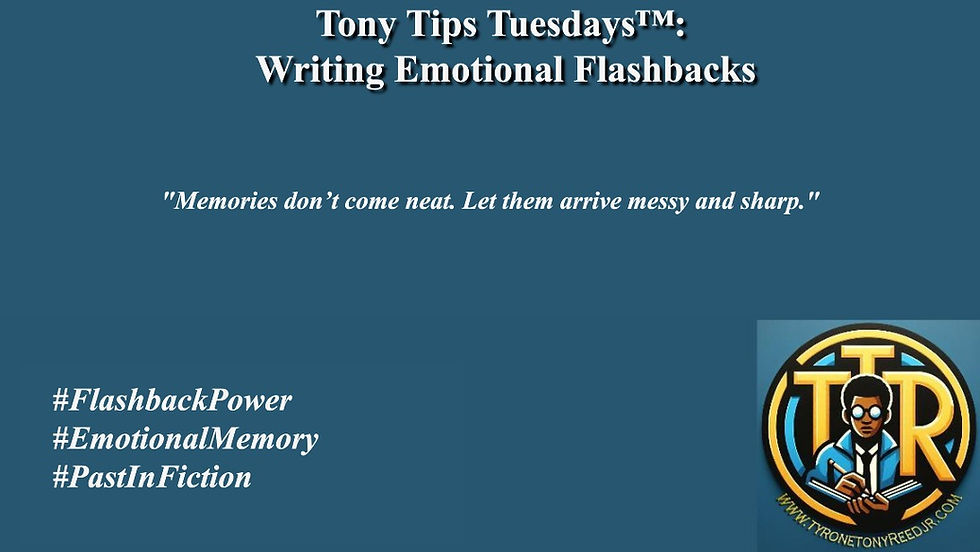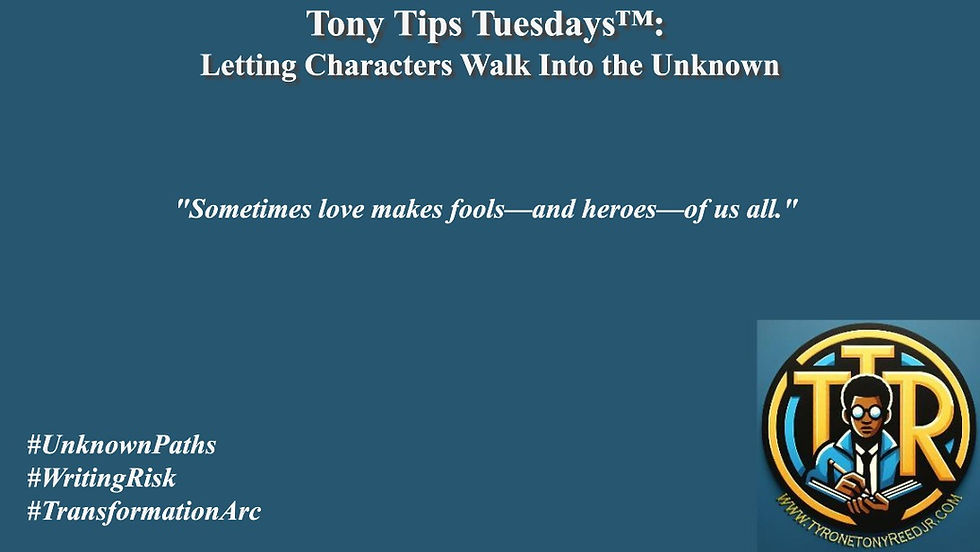Tony Tips Tuesdays™: Writing Strong Female Characters
- Tyrone Tony Reed Jr.

- Aug 26
- 5 min read

In every generation of storytelling, female characters have often had to fight to be more than a sidekick, a love interest, or a plot device. But that tide has turned—and as writers, we are responsible for making sure it stays turned.
A strong female character is not strong because she’s emotionless or flawless or invincible. She’s strong because she’s real. Because she has agency. Because she struggles, grows, leads, fails, and fights to define herself in a world that often wants to do it for her.
This week’s Tony Tips Tuesdays™ is all about crafting strong female characters who are layered, dynamic, and unforgettable. Let’s dive in.
💪🏾 What Strong Really Means
Before we get into technique, let’s define what a “strong female character” truly is—and isn’t.
Not this:
A woman who can physically overpower men in every scene
A woman who never cries, feels, or needs help
A one-note “badass” without flaws or complexity
But this:
A woman with inner strength, emotional depth, and personal agency
A woman who has goals, fears, and contradictions
A woman who exists for herself, not just for the male protagonist
📌 Tony Tip: Strength isn’t about perfection. It’s about presence, power, and purpose.
✍🏾 1. Give Her Agency
Agency means that your character makes decisions, takes action, and influences the world around her.
Ask yourself:
Does she drive her own story forward?
Is she actively solving problems or just reacting to others?
Can the plot still function without her?
If your character is simply a passenger in someone else’s journey, she doesn’t have agency. Give her the wheel.
📌 Tony Tip: Your female lead should have goals—and those goals shouldn’t just be romance or revenge.
🧠 2. Make Her Flawed
Perfect characters are boring. We fall in love with characters because of their imperfections, not in spite of them.
Some of the most iconic female characters are:
Emotionally guarded (e.g., Jessica Pearson from Suits)
Brilliant but messy (e.g., Shuri from Black Panther)
Vengeful and vulnerable (e.g., Arya Stark from Game of Thrones)
Broken but hopeful (e.g., Rue from Euphoria)
Let your character mess up. Let her be wrong. Let her learn. That’s strength.
📌 Tony Tip: Flaws don’t make a character weak—they make her human.
🎭 3. Show the Full Spectrum of Emotion
A strong female character should be allowed to feel everything:
Joy
Anger
Grief
Compassion
Desire
Fear
Strength is not emotional suppression—it’s emotional authenticity. Let her cry. Let her scream. Let her laugh. Let her be free.
📌 Tony Tip: If male characters can express rage, grief, and vulnerability, so can she.
🗣️ 4. Give Her a Voice That Stands Out
She shouldn’t sound like every other woman in your story—or like a female version of the male lead.
To build her voice:
Consider her background, beliefs, and boundaries
Play with cadence, word choice, and tone
Let her interrupt, challenge, joke, or stay silent when it matters
She should speak with purpose—even in silence.
📌 Tony Tip: Every strong character owns their voice. Let her speak with clarity and confidence.
🌍 5. Build Her World Beyond the Men Around Her
Strong female characters need lives that exist beyond romantic relationships.
Ask yourself:
Who are her friends, mentors, rivals?
What’s her relationship with her family or community?
What does she believe in outside of the main plot?
This depth makes her a person, not a prop.
📌 Tony Tip: If she disappears when the male lead isn’t around, she’s not fully formed yet.
🧱 6. Let Her Break the Mold
Tired tropes to avoid or subvert:
The “strong woman” who exists only to take down men
The “ice queen” with no emotional arc
The “manic pixie dream girl” who fixes the hero
The “damsel in distress” with no real choices
Instead, let her:
Choose her path
Carry the story
Learn from other women
Challenge the expectations placed on her
📌 Tony Tip: Don’t build her to fit the mold—build her to break it.
🔄 7. Give Her an Arc of Her Own
A strong character changes. She learns. She struggles. She transforms.
Give her:
A past that shaped her
A flaw that challenges her
A choice that defines her
A future she builds herself
She should start the story in one place—and end it somewhere new.
📌 Tony Tip: If she’s the same at the end as she was at the beginning, something’s missing.
👑 8. Let Her Exist Without Apology
Strong female characters don’t need to explain their strength. They don’t need to apologize for their ambition, their power, their softness, or their scars.
Let her be:
Bold without being “too much”
Quiet without being “weak”
Angry without being “irrational”
Loving without being “dependent”
📌 Tony Tip: She doesn’t need permission to be powerful. She already is.
📚 Examples of Strong Female Characters Done Right
Need inspiration? Here are just a few:
Celie (The Color Purple) – Meek to empowered, her story is one of survival and rebirth.
Katniss Everdeen (The Hunger Games) – A reluctant hero with real fears, love, and burdens.
Veronica Mars (Veronica Mars) – Smart, sarcastic, emotionally layered.
Viola Davis as Annalise Keating (HTGAWM) – Deeply flawed, emotionally raw, brilliant.
Princess Tiana (The Princess and the Frog) – Hardworking, self-sufficient, driven by her own dreams.
Maxine Shaw (Living Single) – Unapologetically confident, sharp, and complex.
📌 Tony Tip: Watch how these women grow—and how their worlds revolve around more than romance.
✨ Quick Tips to Strengthen Your Female Characters
Don’t define her by trauma alone
Let her have relationships with other women
Give her choices with consequences
Let her fail and come back stronger
Avoid making her “one of the guys” as proof of strength
Make sure she’s not just “strong” because she’s mean
Ask yourself: Would I respect her in real life?
💡 Writing Prompts for Strong Female Leads
Use these to spark your next scene or story:
She finally speaks the truth she’s held in for years—and it changes everything.
She trains her replacement for a role she once fought tooth and nail to earn.
She chooses her mental health over a job, relationship, or dream.
She walks away from someone who “loves” her—but doesn’t respect her.
She saves the day, not with violence, but with wisdom and restraint.
She confronts the woman she used to be—and the one she’s becoming.
📌 Tony Tip: Strength isn’t always loud. Sometimes, it’s the quiet refusal to break.
💬 Final Thoughts: She Deserves More
Strong female characters don’t just “balance out” the cast—they elevate the story. They bring emotion, leadership, complexity, and power to every page they touch.
As writers, we don’t just build characters. We build possibilities. We create reflections. We challenge norms.
So write her well. Write her layered. Write her real.
📌 Tony Tip: Don’t write her to please the reader. Write her to honor the woman she could be.
📚 Want to See Strong Female Characters in Action?
Meet Juanita Grayson a.k.a Angeline™ in S.O.L.A.D.™: Soldiers of Light Against Darkness™.
She’s not a sidekick. She’s not a shadow. She’s a fierce, faithful, battle-tested woman with her own purpose, pain, and power.
🔥 Grab your autographed copies of Book I and Book II directly from me at:👉🏾 www.tyronetonyreedjr.com/the-shop
📌 Tony Tip: When you write women who feel real, readers never forget them.



Comments